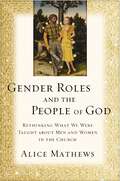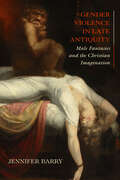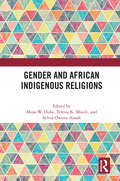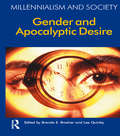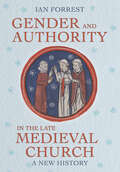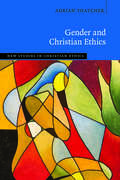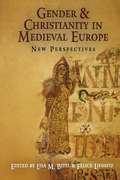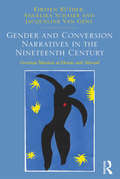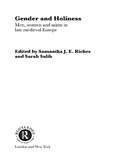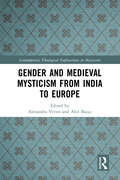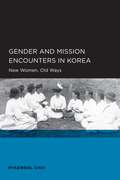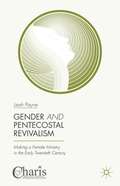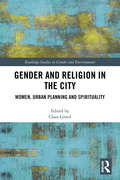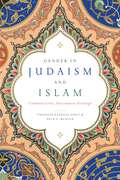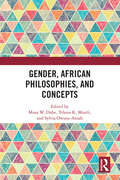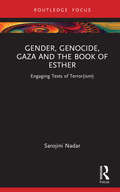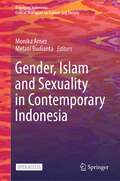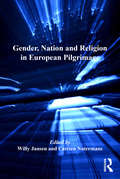- Table View
- List View
Gender Roles and the People of God: Rethinking What We Were Taught about Men and Women in the Church
by Alice MathewsMost women in the church don't aspire to "lord" it over men, nor do they want to scramble for position. Instead, they want to be accepted as full participants in God's work, sharing in kingdom tasks in ways that use their gifts appropriately.In Gender Roles and the People of God, author, radio host, and professor at Gordon-Conwell Theological Seminary, Alice Mathews surveys the roles women have played in the Bible and throughout church history, demonstrating both the inspiring contributions of women and the many hurdles that have been placed in their path. Along the way, she investigates the difficult passages often used to preclude women from certain areas of service, pointing to better and more faithful understandings of those verses.Encouraging and hopeful, Mathews aims for an "egalitarian complementarity" in which men and women use all of their gifts in the church together, in partnership, for the glory of God.
Gender Violence in Late Antiquity: Male Fantasies and the Christian Imagination
by Jennifer BarryGender Violence in Late Antiquity confronts the violent ideological frameworks underpinning the early Christian imagination, arguing that gender-based violence is not peripheral but is fundamental to understanding early Christian history. By analyzing hagiographical and doctrinal writings, Jennifer Barry reveals how male authors used portrayals of feminized suffering to shape ideals of sanctity and power, exploiting themes of domestic abuse, martyrdom, and sexualized violence to reinforce their visions of piety. The study first traces the roots of gendered violence within the Greco-Roman and early Christian imagination, and then explores the disturbing role of male fantasies and dreams in hagiographical traditions. Barry draws on womanist scholarship and engages with trauma studies and feminist horror theory in order to challenge traditional readings of Christian texts, offering new perspectives for understanding how narratives of violence continue to shape contemporary interpretations of gender and power.
Gender and African Indigenous Religions
by Musa W. Dube Telesia K. Musili Sylvia Owusu-AnsahFocusing on the work of contemporary African women researchers, this volume explores feminist perspectives in relation to African Indigenous Religions (AIR). It evaluates what the Circle of Concerned African Women Theologians’ research has achieved and proposed since its launch in 1989, their contribution to the world of knowledge and liberation, and the potential application to nurturing a justice-oriented world. The book considers the methodologies used amongst the Circle to study African Indigenous Religions, the AIR sources of knowledge that are drawn on, and the way in which women are characterized. It reflects on how ideas drawn from African Indigenous Religions might address issues of patriarchy, colonialism, capitalism, racism, tribalism, and sexual and disability-based discrimination. The chapters examine theologies of specific figures. The book will be of interest to scholars of religion, gender studies, Indigenous studies, and African studies.
Gender and Apocalyptic Desire: Gender And Apocalyptic Desire (Millennialism and Society #Vol. 1)
by Brenda E. Brasher Lee QuinbyThe female body has been an object of oppression and control throughout history. 'Gender and Apocalyptic Desire' exposes the often-hidden links between the struggles of women and the conflict of good versus evil. The essays examine the collisions between feminist and apocalyptic thought, the ways in which apocalyptic belief functions as bodily discipline and cultural practice, and how some currents of apocalyptic desire can enable women's equality. A wide range of issues are examined, from anti-abortion terrorism to the stigmata of Christ and visions of Mary.
Gender and Authority across Disciplines, Space and Time
by Adele Bardazzi Alberica BazzoniThis edited collection investigates the relationship between gender and authority across geographical contexts, periods and fields. Who is recognized as a legitimate voice in debate and decision-making, and how is that legitimization produced? Through a variety of methodological approaches, the chapters address some of the most pressing and controversial themes under scrutiny in current feminist scholarship and activism, such as pornography, political representation, LGBTI struggles, female genital mutilation, the #MeToo movement, abortion, divorce and consent. Organized into three sections, “Politics,” “Law and Religion,” and “Imaginaries,” the contributors highlight formal and informal aspects of authority, its gendered and racialized configurations, and practices of solidarity, resistance and subversion by traditionally disempowered subjects. In dialogue with feminist scholarship on power and agency, the notion of authority as elaborated here offers a distinctive lens to critique political and epistemic foundations of inequality and oppression, and will be of use to scholars and students across gender studies, sociology, politics, linguistics, theology, history, law, film, and literature.
Gender and Authority in the Late Medieval Church: A New History (Medieval Societies, Religions, and Cultures)
by Ian ForrestGender and Authority in the Late Medieval Church asks a deceptively simple question: How did the governance of the medieval institutional church remain exclusively male, despite plentiful evidence of women being as capable and devout as men? The remarkable endurance of an all-male clergy is an important element of medieval church government—one that is frequently taken for granted in the historiography—and is connected to another overlooked feature of episcopal authority: the strategies that bishops used to secure the compliance of a relatively autonomous clergy. As Ian Forrest shows, bishops kept their clergy in check through normative standards of masculinity that necessarily disqualified women from leadership roles. Everywhere in the medieval church were women who had the capacity, the resources, and often the ambition to take part in governance, from abbesses to priests' servants, mothers, sisters, and unofficial wives. Bringing together evidence of female activity at the margins of the institutional church, Forrest argues that the male monopoly on formal power was haunted by female capability and aspiration at every turn. Drawing on case studies from the English diocesan clergy between the mid-thirteenth and early sixteenth centuries, he explores how women's involvement in governance was rendered unthinkable through the very discursive strategies that bishops used to control their male clergy. In doing so, Gender and Authority in the Late Medieval Church tells an integrated history that explains how both the exclusion of women and the inclusion of men underpin a rigidly gendered system of religious governance.
Gender and Christian Ethics (New Studies in Christian Ethics)
by Adrian ThatcherIn this book, Adrian Thatcher offers fresh theological arguments for expanding our understanding of gender. He begins by describing the various meanings of gender and depicts the relations between women and men as a pervasive human and global problem. Thatcher then critiques naive and harmful theological accounts of sexuality and gender as binary opposites or mistaken identities. Demonstrating that the gendered theologies of Hans Urs von Balthasar and Karl Barth, as well as the Vatican's “war on gender” rest on questionable binary models, he replaces these models with a human continuum that allows for sexual difference without assuming “opposite sexes” and normative sexualities. Grounded in core Christian doctrines, this continuum enables a full theological affirmation of LGBTIQ people. Thatcher also addresses the excesses of the male/female binary in secular culture and outlines a hermeneutic that delivers justice and acceptance instead of sexism and discrimination.
Gender and Christianity in Medieval Europe
by Lisa M. Bitel Felice LifshitzIn Gender and Christianity in Medieval Europe, six historians explore how medieval people professed Christianity, how they performed gender, and how the two coincided. Many of the daily religious decisions people made were influenced by gender roles, the authors contend. Women's pious donations, for instance, were limited by laws of inheritance and marriage customs; male clerics' behavior depended upon their understanding of masculinity as much as on the demands of liturgy. The job of religious practitioner, whether as a nun, monk, priest, bishop, or some less formal participant, involved not only professing a set of religious ideals but also professing gender in both ideal and practical terms. The authors also argue that medieval Europeans chose how to be women or men (or some complex combination of the two), just as they decided whether and how to be religious. In this sense, religious institutions freed men and women from some of the gendered limits otherwise imposed by society.Whereas previous scholarship has tended to focus exclusively either on masculinity or on aristocratic women, the authors define their topic to study gender in a fuller and more richly nuanced fashion. Likewise, their essays strive for a generous definition of religious history, which has too often been a history of its most visible participants and dominant discourses. In stepping back from received assumptions about religion, gender, and history and by considering what the terms "woman," "man," and "religious" truly mean for historians, the book ultimately enhances our understanding of the gendered implications of every pious thought and ritual gesture of medieval Christians.Contributors:Dyan Elliott is John Evans Professor of History at Northwestern University. Ruth Mazo Karras is professor of history at the University of Minnesota, and the general editor of The Middle Ages Series for the University of Pennsyvlania Press. Jacqueline Murray is dean of arts and professor of history at the University of Guelph. Jane Tibbetts Schulenberg is professor of history at the University of Wisconsin--Madison
Gender and Conversion Narratives in the Nineteenth Century: German Mission at Home and Abroad
by Kirsten Rüther Angelika SchaserAddressing an important social and political issue which is still much debated today, this volume explores the connections between religious conversions and gendered identity against the backdrop of a world undergoing significant social transformations. Adopting a collaborative approach to their research, the authors explore the connections and differences in conversion experiences, tracing the local and regional rootedness of individual conversions as reflected in conversion narratives in three different locations: Germany and German missions in South Africa and colonial Australia, at a time of massive social changes in the 1860s. Beginning with the representation of religious experiences in so-called conversion narratives, the authors explore the social embeddedness of religious conversions and inquire how people related to their social surroundings, and in particular to gender order and gender practices, before, during and after their conversion. With a concluding reflective essay on comparative methods of history writing and transnational perspectives on conversion, this book offers a fresh perspective on historical debates about religious change, gender and social relations.
Gender and Holiness: Men, Women and Saints in Late Medieval Europe (Routledge Studies in Medieval Religion and Culture #No.1)
by Samantha J. E. Riches Sarah SalihThis collection brings together two flourishing areas of medieval scholarship: gender and religion. It examines gender-specific religious practices and contends that the pursuit of holiness can destabilise binary gender itself. Though saints may be classified as masculine or feminine, holiness may also cut across gender divisions and demand a break from normally gendered behaviour. This work of interdisciplinary cultural history includes contributions from historians, art historians and literary critics and will be of interest not only to medievalists, but also to students of religion and gender in any period.
Gender and Medieval Mysticism from India to Europe (Contemporary Theological Explorations in Mysticism)
by Alexandra Verini Abir BazazThis book opens up a dialogue between pre-modern women identified as mystics in diverse locations from South Asia to Europe. It considers how women from the disparate religious traditions of Hinduism, Islam, and Christianity expressed devotion in parallel ways. The argument is that women’s mysticism demands to be compared not because of any essential "female" experience of the divine but because the parallel positions of marginalization that pre-modern women experienced led them to deploy intimate encounters with the divine to speak publicly and claim authority. The topics covered range from the Sufi devotional tradition of Sidis (Indians of African ancestry) to the Bhakti poet Mīrābaī and the nuns of Barking Abbey. Collectively the chapters show how mysticism allowed premodern women to speak and act by unsettling traditional gender roles and expectations for religious behavior. At the same time as uncovering connections, the juxtaposition of women from different traditions serves to highlight distinctive features. The book draws on a range of disciplinary expertise and will be of particular interest to scholars of medieval religion and theology as well as history and literary studies.
Gender and Mission Encounters in Korea: New Women, Old Ways
by Hyaeweol ChoiThis book traces the genealogy of modern womanhood in the encounters between Koreans and American Protestant missionaries in the early twentieth century. Hyaeweol Choi's textured, historically specific analysis shows that what it meant to be a "modern" Korean woman was deeply bound up in Korean nationalism.
Gender and Narrative in the Mahabharata (Routledge Hindu Studies Series)
by Simon Brodbeck Brian BlackThe Sanskrit Mahabharata is one of the most important texts to emerge from the Indian cultural tradition. At almost 75,000 verses it is the longest poem in the world, and throughout Indian history it has been hugely influential in shaping gender and social norms. In the context of ancient India, it is the definitive cultural narrative in the construction of masculine, feminine and alternative gender roles. This book brings together many of the most respected scholars in the field of Mahabharata studies, as well as some of its most promising young scholars. By focusing specifically on gender constructions, some of the most innovative aspects of the Mahabharata are highlighted. Whilst taking account of feminist scholarship, the contributors see the Mahabharata as providing an opportunity to frame discussion of gender in literature not just in terms of the socio-historical roles of men and women. Instead they analyze the text in terms of the wider poetic and philosophical possibilities thrown up by the semiotics of gendering. Consequently, the book bridges a gap in text-critical methodology between the traditional philological approach and more recent trends in gender and literary theory. Gender and Narrative in the Mahabharata will be appreciated by readers interested in South Asian studies, Hinduism, religious studies and gender studies.
Gender and Orthodox Christianity: Dynamics of Tradition, Culture and Lived Practice (Routledge Studies in Religion)
by Elina Vuola Helena KupariThe Orthodox Christian tradition has all too often been sidelined in conversations around contemporary religion. Despite being distinct from Protestantism and Catholicism in both theology and practice, it remains an underused setting for academic inquiry into current lived religious practice. This collection, therefore, seeks to redress this imbalance by investigating modern manifestations of Orthodox Christianity through an explicitly gender-sensitive gaze. By addressing attitudes to gender in this context, it fills major gaps in the literature on both religion and gender. Starting with the traditional teachings and discourses around gender in the Orthodox Church, the book moves on to demonstrate the diversity of responses to those narratives that can be found among Orthodox populations in Europe and North America. Using case studies from several countries, with both large and small Orthodox populations, contributors use an interdisciplinary approach to address how gender and religion interact in contexts such as, iconography, conversion, social activism and ecumenical relations, among others. From Greece and Russia to Finland and the USA, this volume sheds new light on the myriad ways in which gender is manifested, performed, and engaged within contemporary Orthodoxy. Furthermore, it also demonstrates that employing the analytical lens of gender enables new insights into Orthodox Christianity as a lived tradition. It will, therefore, be of great interest to scholars of both Religious Studies and Gender Studies.
Gender and Pentecostal Revivalism
by Leah PayneThis innovative volume provides an interdisciplinary, theoretically innovative answer to an enduring question for Pentecostal/charismatic Christianities: how do women lead churches? This study fills this lacuna by examining the leadership and legacy of two architects of the Pentecostal movement - Maria Woodworth-Etter and Aimee Semple McPherson.
Gender and Power in Contemporary Spirituality: Ethnographic Approaches (Routledge Studies in Religion #26)
by Anna Fedele Kim E. KnibbeThis book explores the entanglements of gender and power in spiritual practices and analyzes strategies used by spiritual practitioners to attain what to social scientists might seem an impossible goal: creating spiritual communities without creating gendered hierarchies. What strategies do people within these networks use to attain gender equality and gendered empowerment? How do they try to protect and develop individual freedom? How do gender and power nevertheless play a role? The chapters in this book together and separately demonstrate that, in order to understand contemporary spirituality, the analytical lenses of gender and power are essential. Furthermore, they show that it is not possible to make a clear distinction between established religions and contemporary spirituality: the two sometimes overlap, and at other times spirituality distances itself from religion while reproducing some of its underlying interpretative frameworks. This book does not take the discourses of spiritual practitioners for granted, yet recognizes the reflexivity of spiritual practitioners and the reciprocal relationship between spirituality and disciplines such as anthropology. The ethnographic descriptions of lived spirituality included in this volume span a wide range of countries, from Portugal, Italy, and the Netherlands to Mexico and Israel.
Gender and Power in Medieval Exegesis
by Theresa TinkleAfter establishing a feminist-historicist perspective on the tradition of biblical commentary, Tinkle develops in-depth case studies that situate scholars reading the bible in three distinct historical moments, and in so doing she exposes the cultural pressures that medieval scholars felt as they interpreted the bible.
Gender and Religion in the City: Women, Urban Planning and Spirituality (Routledge Studies in Gender and Environments)
by Clara GreedThis book provides a conceptual, historical and contemporary context to the relationships between gender, religion and cities. It draws together these three components to provide an innovative view of how religion and gender interact and affect urban form and city planning. While there have been many books that deal with religion and cities; gender and cities; and gender and religion, this book is unique in bringing these three subjects together. This trio of inter-relationships is first explored within Western Christianity: in Roman Catholicism, Protestantism, Eastern Orthodoxy and in the Pentecostal and Charismatic movements. A wider perspective is then provided in chapters on the ways in which Islam shapes urban development and influences the position of Muslim women in urban space. While official religions have declined in the West there is still a desire for new forms of spirituality, and this is discussed in chapters on municipal spirituality and on the rise of paganism and the links to both environmentalism and feminism. Finally, ways of taking into account both gender and religion within the statutory urban planning system are presented. This book will be of great interest to those researching environment and gender, urban planning and sustainability, human geography and religion.
Gender and Sexuality in Muslim Cultures
by Gul OzyeginA must-read for anyone interested in Muslim cultures, this volume not only explores Muslim identities through the lens of sexuality and gender - their historical and contemporary transformations and local and global articulations - but also interrogates our understanding of what constitutes a ’Muslim’ identity in selected Muslim-majority countries at this pivotal historical moment, characterized by transformative destabilizations in which national, ethnic, and religious boundaries are being re-imagined and re-made. Contributors take on the most fundamental questions at the intersections of gender, sexuality, and the body. Several overarching questions frame the volume: How does studying gender and sexuality expand and enrich our understanding of Muslim-majority countries, historically and at present? How does the embodiment of ’Muslim’ identity get reconfigured in the context of twenty-first-century globalism? What analytical questions are raised about ’Islam’ when its diverse meanings and multifaceted expressions are closely examined? What roles do gender and sexuality play in the construction of cultural, religious, nationalistic, communal, and militaristic identities? How have power struggles been signified in and on the bodies of women and sexuality? How have global dynamics, such as the intensification and spread of neoliberal ideologies and policies, affected changing dynamics of gender and sexuality in specific locales? Here global dynamics touch down in diverse contexts, from masculinity crises around war disabilities, transnational marriages, and fathering in Turkey, Egypt, and Pakistan; to Muslim femininity narratives around female genital cutting, sexuality in divorce proceedings, and spouse selection; to gender crossing practices as well as protesting bodies, queering voices, and claims of authenticity in literary and political discourse. This book brings exciting research on these and other topics together in one place, allowing the essa
Gender and Timebound Commandments in Judaism
by Elizabeth Shanks AlexanderThe rule that exempts women from rituals that need to be performed at specific times (so-called timebound, positive commandments) has served for centuries to stabilize Jewish gender. It has provided a rationale for women's centrality at home and their absence from the synagogue. Departing from dominant popular and scholarly views, Elizabeth Shanks Alexander argues that the rule was not conceived to structure women's religious lives, but rather became a tool for social engineering only after it underwent shifts in meaning during its transmission. Alexander narrates the rule's complicated history, establishing the purposes for which it was initially formulated and the shifts in interpretation that led to its being perceived as a key marker of Jewish gender. At the end of her study, Alexander points to women's exemption from particular rituals (Shema, tefillin, and Torah study), which, she argues, are better places to look for insight into rabbinic gender.
Gender in Judaism and Islam: Common Lives, Uncommon Heritage
by Firoozeh Kashani-Sabet & Beth S. WengerJewish andIslamic histories have long been interrelated. Both traditions emerged fromancient cultures born in the Middle East and both are rooted in texts andtraditions that have often excluded women. At the same time, both groups haverecently seen a resurgence in religious orthodoxy among women, as well asgrowing feminist movements that challenge traditional religious structures. In theUnited States, Jews and Muslims operate as minority cultures, carving out aplace for religious and ethnic distinctiveness. The time is ripe for a volumethat explores the relationship between these two religions through the prism ofgender.Gender in Judaism and Islam brings togetherscholars working in the fields of Judaism and Islam to address a diverse rangeof topics, including gendered readings of texts, legal issues in marriage anddivorce, ritual practices, and women's literary expressionsand historical experiences, along with feminist influences within the Muslimand Jewish communities and issues affecting Jewish and Muslim women incontemporary society. Carefully crafted, including section introductions by theeditors to highlight big picture insights offered by the contributors, thevolume focuses attention on the theoretical innovations that gender scholarshiphas brought to the study of Muslim and Jewish experiences.At a timewhen Judaism and Islam are often discussed as though they were inherently atodds, this book offers a much-needed reconsideration of the connections andcommonalties between these two traditions. It offers new insights into each ofthese cultures and invites comparative perspectives that deepen ourunderstanding of both Islam and Judaism.
Gender, African Philosophies, and Concepts
by Musa W. Dube Telesia K. Musili Sylvia Owusu-AnsahThis volume sets out to explore, propose, and generate feminist theories based on African indigenous philosophies and concepts. It investigates specific philosophical and ethical concepts that emerge from African indigenous religions and considers their potential for providing feminist imagination for social justice-oriented earth communities. The contributions examine African indigenous concepts such as Ubuntu, ancestorhood, trickster discourse, Mupo, Akwaaba, Tukumbeng, Eziko, storytelling, and Ngozi . They look to deconstruct oppressive social categories of gender, class, ethnicity, race, colonialism, heteronormativity, and anthropocentricism. The book will be of interest to scholars of religion, philosophy, gender studies, and African studies.
Gender, Genocide, Gaza and the Book of Esther: Engaging Texts of Terror(ism) (Rape Culture, Religion and the Bible)
by Sarojini NadarGender, Genocide, Gaza and the Book of Esther bridges the gap between gendered and geopolitical analyses by interrogating both the sexual and ethnic violence embedded in the Book of Esther. While much scholarship has examined the potential genocide of the Jews in the narrative, far less attention has been paid to the Persian “retaliation genocide.” Framed within decolonial feminist perspectives, this book shifts between the harem—the royal institution where women were sequestered for the king’s use—and herem, the practice of divinely sanctioned warfare that justifies the extermination of an enemy. Rather than operating as discrete forms of violence, the book argues that the harem and the herem are co-constitutive, revealing how gendered and ethnic domination function in tandem. Through a combination of narrative inquiry, inter-textual readings, critical discourse analysis, and theological assessments of both the biblical text and its contemporary reception, Gender, Genocide, Gaza and the Book of Esther invites interpreters to consider the larger frameworks of ethnicity and racialization within which hermeneutics of sexual violence take place. A close literary reading of Esther is paired with an analysis of its contemporary geopolitical appropriations, particularly its use in Christian Zionist rhetoric. The explicit invocation of the Amalekite extermination trope by Israel’s prime minister in October 2023 to justify attacks on Gaza, underscores the enduring political afterlives of texts of terror. This book contends that a feminist reading of Esther cannot limit itself to an analysis of sexual violence but must extend its critique intersectionally, engaging with the broader necropolitical economies that structure both ancient and modern deployments of biblical violence.
Gender, Islam and Sexuality in Contemporary Indonesia (Engaging Indonesia)
by Melani Budianta Monika ArnezThis Open Access book explores the complex interplay between gender, Islam and sexuality in Indonesia, the country with the world's largest Muslim population. The authors offer a fresh look at the tensions between the local and the global through a wide range of cultural expressions and productions, including fashion, Islamic dating, popular literature, and videos on YouTube. The book is grouped around three core themes: sexuality and violence, halal lifestyle, and shame and self-determination. The first section unpacks how activists and progressive religious scholars have argued for the need for the Sexual Violence Bill and it examines the ambivalence between criminalisation and care towards LGBTQ+ people. In the second, the authors bring new insights into how local expressions of Islam, gender and sexuality are negotiated in an increasingly globalised world. The contributions on the third theme tackle gender roles and mobility in culturally diverse regions such as Hong Kong,Taiwan, Singapore, the US, and Indonesia. "The volume is a must-read for anyone wanting to get up to speed on changes in Indonesia's gender, sexuality and Islamic landscape." - Professor Sharyn Graham Davies, Director of the Herb Feith Indonesia Engagement Centre, Monash University, Australia "A showcase of excellent research, this book is of appeal to Indonesian studies scholars, and to readers in the field of Asian cultural studies. It is also of relevance to the field of Asian gender and sexuality studies, and to scholars in Islamic studies." - Professor Pamela Nilan, University of Newcastle, Australia
Gender, Nation and Religion in European Pilgrimage: Old Routes New Journeys
by Catrien NotermansDespite the forces of secularization in Europe, old pilgrimage routes are attracting huge numbers of people and given new meanings in the process. In pilgrimage, religious or spiritual meanings are interwoven with social, cultural and politico-strategic concerns. This book explores three such concerns under intense debate in Europe: gender and sexual emancipation, (trans)national identities in the context of migration, and European unification and religious identifications in a changing religious landscape. The interdisciplinary contributions to this book explore a range of such controversies and issues including: Africans renewing family ties at Lourdes, Swedish women at midlife or young English men testing their strength on the Camino to Santiago de Compostela, New Age pilgrims and sexuality, Saints’ festivals in Spain and Brittany, conservative Catholics challenging Europe’s liberal policies on abortion, Polish migrants and French Algerians reconfiguring their transnational identity by transporting their familiar Madonna to their new home, new sacred spaces created such as the shrine of Our Lady of Santa Cruz, traditional Christian saints such as Mary Magdalene given new meanings as new age goddess, and foundation legends of shrines revived by new visionaries. Pilgrimage sites function as nodes in intersecting networks of religious discourses, geographical routes and political preoccupations, which become stages for playing out the boundaries between home and abroad, Muslims and Christians, pilgrimage and tourism, Europe and the world. This book shows how the old routes of Europe are offering inspirational opportunities for making new journeys.
